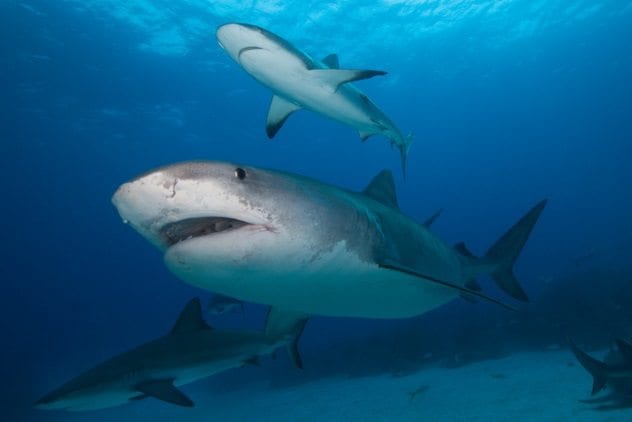 Facts
Facts  Facts
Facts  Crime
Crime 10 Dark Details of Australia’s Gruesome Unsolved Wanda Murders
 Humans
Humans 10 Unsung Figures Behind Some of History’s Most Famous Journeys
 Animals
Animals 10 Species That Refused to Go Extinct
 Weird Stuff
Weird Stuff 10 Weird Things People Used to Do at New Year’s
 Our World
Our World 10 Archaeological Discoveries of 2025 That Refined History
 Weird Stuff
Weird Stuff 10 Fascinating Facts You Might Not Know About Snow
 Miscellaneous
Miscellaneous Top 10 Things Crypto Was Supposed to Change & What Actually Did
 History
History 10 Huge Historical Events That Happened on Christmas Eve
 Music
Music 10 Surprising Origin Stories of Your Favorite Holiday Songs
 Facts
Facts Ten Unexpectedly Fascinating Facts About Rain
 Crime
Crime 10 Dark Details of Australia’s Gruesome Unsolved Wanda Murders
 Humans
Humans 10 Unsung Figures Behind Some of History’s Most Famous Journeys
Who's Behind Listverse?

Jamie Frater
Head Editor
Jamie founded Listverse due to an insatiable desire to share fascinating, obscure, and bizarre facts. He has been a guest speaker on numerous national radio and television stations and is a five time published author.
More About Us Animals
Animals 10 Species That Refused to Go Extinct
 Weird Stuff
Weird Stuff 10 Weird Things People Used to Do at New Year’s
 Our World
Our World 10 Archaeological Discoveries of 2025 That Refined History
 Weird Stuff
Weird Stuff 10 Fascinating Facts You Might Not Know About Snow
 Miscellaneous
Miscellaneous Top 10 Things Crypto Was Supposed to Change & What Actually Did
 History
History 10 Huge Historical Events That Happened on Christmas Eve
 Music
Music 10 Surprising Origin Stories of Your Favorite Holiday Songs
10 Horrors Faced By The Convicts Of Devil’s Island
The French penal colony commonly known as Devil’s Island consisted of small, closely situated islands off the coast of French Guiana. There are different accounts as to who went to which island, but many of the most vicious criminals, such as murderers and rapists, were sent to the colony. In later years, it also housed political prisoners or anyone who somehow displeased France.
Devil’s Island was described as being “one huge rock.” It was roughly 34 acres in area and 19 meters (63 ft) above sea level. It was hardly a place to call home, and many prisoners who survived the torments of life there referred to their time as a “living death” and called the prison itself a “dry guillotine.”
Devil’s Island operated from 1852 to 1946. It is estimated that during this time, as many as 40 percent of the new arrivals died within the first year. Only the toughest and most obedient could survive there.
10 The Prison Ship

The trip to Devil’s Island was deadly for many of the convicts. They were loaded onto the ship and immediately lost their individual identities. They became a number, and no one gave a care if they lived or died.
The men were led down belowdecks and stuffed into cages. There was hardly any air to breathe in the darkness, and the cages had only hammocks to sleep on. If the men grew thirsty, they had to reach outside their cages and dip their cups into the stale water barrel left there for them.
As the ship sailed into the hot, tropical air, the men grew angry. They fought among themselves, and murders were very common inside the cages. Disease was rampant, and the food rations were scarce. Many of the prisoners died long before the ship would reach the penal islands.
9 A Good Scalding

The prisoners had no choice but to be well-behaved for the guards on the ships. If any of the prisoners tried to escape their cage or cause a mutiny, they were quickly and horribly subdued.
Fitted inside the cages on the prisoner ship were steam pipes. If any of the prisoners attempted to escape the cage, hot steam would be released into the cage, scalding all the prisoners inside. The pipes were a clear reminder to all the prisoners held under the deck. They could behave themselves and obey orders, or they could suffer the consequences of their actions.
8 The Sweet Smell Of Sulfur

If the prisoners grew too loud inside their cages, the guards had another method of subduing the men aside from the hot steam.
Sliding metal doors were built around the cages, and in the event of too much noise or even singing, the guards would light up sticks of sulfur, throw them into the cages, and close off the air supply with the sliding doors.
In one reported case of the sulfur sticks being used, a witness stated:
The men in the cages began to cough, and then utter hoarse screams. One continued to sing loud and defiantly, until the song ended in a lung-splitting spasm of coughing. In the end there was no other sound than moans and whimpers. The sulphur had conquered, as it always does on these occasions.
7 Too Deadly To Escape

When the prisoners would first reach the island, they were often boosted by the sight of so little surveillance along the prison walls. Their minds quickly turned to the thought of escape, but just as soon as hope arose, it was crushed.
The water between the islands and the mainland was wild and dangerous. The currents raged, and deadly sharks lurked beneath the waves. According to one account, “Seldom, if ever, does the body sink below the waves before being torn to pieces by the sharks.”
Even if a man could make it to the mainland, he would be faced with deadly jungles. Without food or the tools necessary for basic survival, he would quickly perish in the wilds.
6 Shackles And Restraints

As soon as the men were on the island, they were placed in shackles. During the day, they moved about in chains, but at night, they were often double-shackled so that they couldn’t move during sleep.
The men suffered from starvation, and many died from fever. Their bodies would be loaded onto wheelbarrows and dumped into the sea. A funeral bell was rung, which may as well have been a dinner bell because witnesses stated that when the bell rang, the sharks began to circle about, waiting for whatever was to be tossed into the waters.
5 Solitary Confinement

For prisoners who didn’t obey the rules and do as they were told, the punishment could very well be solitary confinement. The minimum sentencing for solitary confinement was six months. During this time, the prisoner would only get one hour of exercise a day. The rest of his time was spent alone.
Undoubtedly, many men went insane serving their time in solitary, but if this punishment failed to tame the prisoner, he would be sentenced to hard labor in the jungle, where, more than likely, he would die.
4 Left To The Elements

For the most brutal killers was the most brutal punishment. In 1931, a case was reported of a prisoner who turned on a guard and beat the man to death. To make an example of the prisoner, the guards took him to the jungle, where his work group was stationed, and chained him to a tree. He was left for the elements, insects, snakes, and starvation.
His fellow prisoners were taken back to prison after their shift in the jungle was over, leaving the chained man behind. The next day, the condemned prisoner was slumped in his upright position, still alive but quiet. The following day, he was dead.
The prisoner’s punishment no doubt left a lasting impression on the remaining prisoners, who knew that their lives were truly in the hands of the guards.
3 No Pity For The Injured

It is reported in multiple sources that the prisoners on Devil’s Island had no shoes. They were forced to work in the jungle without any protection on their feet. If any of the prisoners became injured, the guards had little concern over the matter.
In one instance, a middle-aged man was hobbling back to the dungeons after working all day in the jungle, and a guard grew impatient with his slow walk. He tried to hustle the prisoner on, but the man pointed to the bottom of his foot, showing him the raw, bloody flesh. The guard didn’t care and prodded the man forward. The prisoner tried to walk faster but stopped again because of the pain. This time, the guard struck him hard across the back. The man had to keep moving or risk being beaten to death or facing some other punishment for insubordination.
2 Chasing After Butterflies

In a truly bizarre newspaper article printed in 1933, a former French official who worked on Devil’s Island talked about how he taught the prisoners to identify a rare butterfly and how to catch it for him. Apparently, this former official, M. Eugene Le Moult, was a rare butterfly collector and boasted that his collection contained at least 4.5 million rare butterflies set in some 30,000 boxes.
After teaching some of the convicts how to safely capture the butterflies, he explained how strange it was to see “murderers and bandits with terrible records running over the island after butterflies.”
1 Parole

After serving their sentences and surviving the grueling atmosphere of the island prison, the prisoners were allowed to leave for for the mainland of French Guiana. They had to serve parole there for as long as they were sentenced to the island. If a man served out his seven years on Devil’s Island, he had to spend another seven years living in French Guiana. He was not allowed to return home until his time was served, and then he had to earn enough money to pay for his trip back across the ocean.
Since there were so few jobs available to former prisoners, some would commit a new crime just to be returned to the island. At least they would often get meager food rations on the island, whereas on the mainland, they could easily die of starvation.
Elizabeth, a former Pennsylvania native, recently moved to the beautiful state of Massachusetts where she is currently involved in researching early American history. She writes and travels in her spare time.






